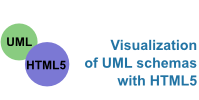
One of the greatest challenges related to the education and research in the field of Requirements Engineering and Conceptual Modeling (RE/CM) is the lack of empirical research on the practical uses of RE/CM, including the impact in practice of the education in CM.
The goal of this project is to create a JavaScript tool that allows the visualization of UML schemas, using the new characteristics in the HTML5 language. The user can dynamically interact with the schema to modifiy and adapt it. It allows the generation of schemas, both graphically – using a web interface to add the elements – and textually – using a specific textual modeling language. To improve the visualization an auto-layout algorithm has been implemented to automatically position the elements in the schema.
The development of any engineering project, from the construction of a text processor to an Internet communication software, requires modeling tasks that allow experimenting and visualizing the system that the stakeholders wish to build. Because these stages are so important when building a system, a tool that facilitates this process will improve both the final result and the time invested in its creation.
One of the problems that we can face during this process is not having a tool that fits our needs, and be forced to use a tool which does not specifically meet all of our requirements. There are many CASE (Computer-aided software engineering) tools which provide methods to do the modeling, but they all have similar issues:
As our tool is implemented in HTML5, its users only need a web browser to use it, without the need to install additional software.
This study has been carried out by researchers from the GMC (Grup de Recerca en Modelització Conceptual de Sistemes d’Informació) group at Universitat Politècnica de Catalunya-BarcelonaTech.
For any question or comment, do not hesitate to get in touch with us by sending an e-mail to avillegas@essi.upc.edu
Below we point out some potential areas for future work, in regards to the evolution of the HTML5 UML schema viewer:
